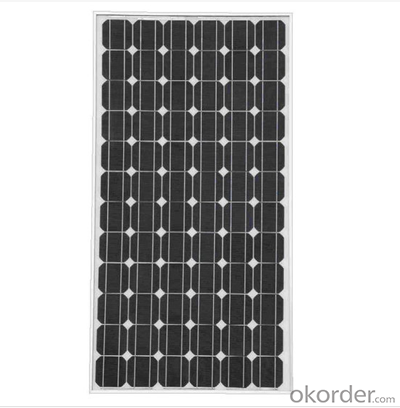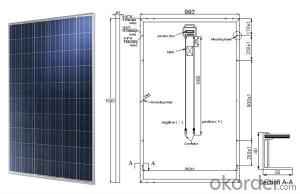Monocrystalline Solar Panel CNPV-210w High Performance 72 Cell
- Loading Port:
- Shanghai
- Payment Terms:
- TT OR LC
- Min Order Qty:
- 25 pc
- Supply Capability:
- 100000 pc/month
OKorder Service Pledge
OKorder Financial Service
You Might Also Like
Product Description:
Solar Monocrystalline Series Panels
Introduction of Solar Monocrystalline Series Panels
CNBM Solar photovoltaic (PV) Panel is designed for large electrical power requirements. It is the optimal choice for both on-grid and off-grid power systems. CNBM Solar panel offers high performance of power per square foot of solar array. Monocrystalline silicon(c-Si): often made using the Czochralski process. Single-crystal wafer cells tend to be expensive, and because they are cut from cylindrical ingots, do not completely cover a square solar cell module without a substantial waste of refined silicon. Hence most c-Si panels have uncovered gaps at the four corners of the cells.
Standard Test Conditions of Solar Monocrystalline Series Panels
The opto-electrical specifications shown below are stabilized values being measured at Standard Test Conditions, Irradiance: 1000W/m2, Spectrum: AM1.5 at 25°C, The info below is subject to manufacturing tolerances. Where appropriate minutes of measurement are available and are used for the dimensioning of the installation.
Advantages of Solar Monocrystalline Series Panels
• Solar performance guarantees for 25 years
• 12 years guarantee for workmanship
• Timeliness of delivery
Characteristics of Solar Monocrystalline Series Panels
Max Power Voltage Vmp (V) | 37.5V |
Max Power Current Imp (A) | 5.6A |
Open Circuit Voltage Voc (V) | 45.95V |
Short Circuit Current Isc (A) | 5.95A |
Max Power Pm (W) | 210W |
Temperature Coefficient of Cells
NOCT | 47℃±2℃ |
Temperature Coefficients of Isc (%/℃) | 0.064 |
Temperature Coefficients of Voc (%/℃) | -0.33 |
Temperature Coefficients of Pmp (%/℃) | -0.45 |
Mechanical Data Solar Monocrystalline Series
Power | 210W |
Dimension | 1581×809×35mm |
Weight | 15kg |
Tolerance | ±3% |
The dimension of the modules can be changed according to the demand of clients
Limits
Operating Temperature | –40 °C to +85°C |
Storage Temperature | –40 °C to +85°C |
Max System Voltage | 700V |
Guarantee Solar Monocrystalline Series Panels
Products Guarantee | 12 yrs free from defects in materials and workmanship |
Performance Guarantee | No less than 90% within 10yrs and no less than 80% within 25yrs |
Certificates | UL, IEC, ISO, TUV, CE |
The Examination of Solar Monocrystalline Series Panels
FAQ
We have organized several common questions for our clients,may help you sincerely:
1. What’s price per watt?
A: It’s depends on the quantity, delivery date and payment terms of the order. We can talk further about the detail price issue. Our products is high quality with lower price level.
2. Can you tell me the parameter of your solar panels?
We have different series of cells with different power output, both from c-si to a-si. Please take our specification sheet for your reference.
3. How do you pack your products?
We have rich experience on how to pack the panels to make sure the safety on shipment when it arrives at the destination.
Normally we put the panels in carton and then in pallets.
4. Can you do OEM for us?
Yes, we can. It will depend on the quantity.
- Q: Can solar panels be installed on restaurants or food establishments?
- Yes, solar panels can be installed on restaurants or food establishments. In fact, many restaurants and food establishments have embraced solar energy as a sustainable and cost-effective solution. Solar panels can be installed on rooftops, parking lots, or even as shade structures over outdoor seating areas. By harnessing solar energy, these businesses can reduce their reliance on traditional energy sources, lower their electricity bills, and contribute to a greener environment.
- Q: Can solar panels be used in areas with high humidity?
- Yes, solar panels can be used in areas with high humidity. However, high humidity levels can affect the overall efficiency of solar panels due to a decrease in their performance. The moisture in the air can cause a film of dirt or dust to accumulate on the panels, reducing their ability to absorb sunlight effectively. Regular cleaning and maintenance can help mitigate these effects and ensure optimal performance.
- Q: Can solar panels be used in areas with high levels of dust storms?
- Yes, solar panels can be used in areas with high levels of dust storms. However, it is important to regularly clean and maintain the panels to ensure optimal performance. Dust storms may cause a temporary decrease in energy production, but it can be mitigated by implementing proper maintenance practices such as cleaning the panels and installing protective measures like dust shields.
- Q: I have a solar panel i got for free and I don't know what to do with it. Its kinda big at about 20x 0and it puts our 2 VOC / .23 ISC. I don't know of anything that I could use it for. Its too big to say charge a phone or ipod....any suggestions??
- Makes a great charger for a boat or car battery. I have one about that size that I have mounted on the fishing platform of my boat. The trolling motor battery is always fully charged when I need it.
- Q: Can solar panels be used to power an air conditioning system?
- Yes, solar panels can be used to power an air conditioning system. Solar panels generate electricity from sunlight, which can be used to run various electrical appliances, including air conditioning units. By harnessing solar energy, it is possible to power an air conditioning system without relying on traditional power sources, leading to energy savings and reduced carbon emissions.
- Q: How much solar energy does a 2m by a 3m solar panel convert to energy on a sunny day? Assume that the solar cells are 30% efficient.I'm not looking for the answer so much as I need an explanation o how to solve this type of problem... Thanks!!
- You have the area of the solar panel. You know their efficiency. What you need to know now is the energy (per area) delivered by the sun. The energy delivered by the sun can be found on the internet. Earth ,43 – ,32 W/m? (wikipedia) That is offcourse for your solar panels perpendicular to the ray's of the sun. If they are under an angle you should see what the area of the projecton of your solar panel is on a plane perpendicular to the ray's of the sun. So know you have the intensity W/m? and an area (or effective area). Here you go the energy deliverd by the sun. And 30% of it is what you get out of your panels.
- Q: Can solar panels be installed in areas with high pollution levels?
- Yes, solar panels can be installed in areas with high pollution levels. While pollution can potentially reduce the efficiency of solar panels, they can still generate electricity even in polluted areas. Regular cleaning and maintenance of the panels can help mitigate the impact of pollution and ensure optimal performance. Additionally, installing solar panels can contribute to reducing pollution by promoting the use of clean and renewable energy sources.
- Q: Are photovoltaic cells the same as solar panels?
- Solar panels are covered with photovoltaic cells that convert sunlight into electricity. So photovoltaic cells are part of solar panel. renewableenergyarticles.blogspot....
- Q: Can solar panels be installed on public transportation systems?
- Yes, solar panels can be installed on public transportation systems. In fact, many cities around the world have already started implementing solar panels on buses, trams, and trains. This allows the vehicles to generate renewable energy and reduce their carbon footprint while operating. The solar panels can be integrated into the roofs or sides of the vehicles, harnessing sunlight to power various onboard systems, such as lighting or air conditioning. This not only helps to make public transportation more sustainable but also saves on energy costs and promotes a greener future for urban mobility.
- Q: Can solar panels be installed on the ground instead of a roof?
- Yes, solar panels can be installed on the ground instead of a roof. Ground-mounted solar panels are a popular alternative when roofs are not suitable or available for installation. Ground-mounted systems offer flexibility in terms of placement, orientation, and size, making them an excellent option for maximizing solar energy production.
Send your message to us
Monocrystalline Solar Panel CNPV-210w High Performance 72 Cell
- Loading Port:
- Shanghai
- Payment Terms:
- TT OR LC
- Min Order Qty:
- 25 pc
- Supply Capability:
- 100000 pc/month
OKorder Service Pledge
OKorder Financial Service
Similar products
Hot products
Hot Searches
Related keywords


























